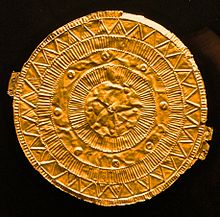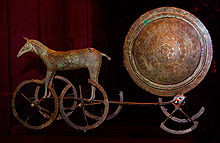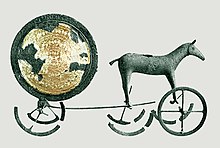Gold disc from Moordorf
The gold disc of Moordorf even solar disk of Moordorf , probably dates back to the period II of the Nordic Bronze Age (1500-1300 v. Chr.). It was discovered in 1910 in the town of the same name in East Frisia . The disk has been part of the Lower Saxony State Museum in Hanover since 1926 . At the beginning of 2016, doubts about the authenticity of the gold disc became known.
Find and exhibition history
The Moordorfer Vitus Dirks found the gold disc in March 1910 at the peat ditch. He misjudged their value and gave them to his children to play with and then put them in his room cupboard. A dealer bought the disc together with an antique ceramic vessel for three marks in 1919 and sold it on to the Aurich scrap metal dealer David Rück. When he moved to Nuremberg shortly afterwards, he took the pane with him. In 1920 he offered the disc to the British Museum in London. However, this refused the offer because the purchase price appeared too high. Shortly afterwards, an archaeologist from the Roman-Germanic Central Museum bought the disk for 450 marks after discovering it in a shop window. In 1926 the museum left it to the Hannover Provincial Museum, the forerunner of today's Lower Saxony State Museum in Hanover , which still owns the pane to this day. Copies of the disc are exhibited in the Moordorf Moor Museum , in the East Frisian State Museum Emden and in the Aurich Historical Museum . There are at least 74 replicas in total.
In the 1920s it was possible to find out who was found and where it was found via a newspaper appeal. In 1927, a follow-up examination was carried out at the site. It turned out that there was probably a 75 centimeter high hill under the now pitted terrain. Traces of a rectangular pit that were 57 centimeters wide and 2.3 meters long were found in the ground. The disc could therefore come from a grave, but it may also have been deliberately deposited as an offering.
The Ostfriesisches Landesmuseum Emden exhibited them for the first time in East Frisia in the first half of 2013 as part of the German-Dutch archeology exhibition "Land of Discoveries - Archeology of the Frisian Coastal Area".
construction
The disc has a diameter of 14.5 centimeters, a material thickness of 0.14 millimeters and a weight of 36.17 grams. It consists of gold mixed with 0.1 percent silver and 0.03 percent lead. In the composition of the gold used, it falls out of all material groups used for Central Europe. It was made from refined, i.e. purified, gold. With the research status of 1982 it was assumed that the gold comes from the eastern Mediterranean.
The very thin sheet was first driven from a small piece of gold. However, the decorations on the front side were not created by placing them on an ornate bronze disc, i.e. shaped using a template, but driven into the disc from behind. Over 1000 lines and dots were individually stamped with hallmarks . This manufacturing technique was alien to the region during Period II of the Nordic Bronze Age .
In the middle, the disk originally had a flat curve, which is now indented. There are eight small nail head-like protrusions on its edge. This is followed by a circle made up of radial rays, a circle of again eight small humps, another circle of rays and finally a circle filled with 32 hatched triangles. The disc also has two tabs that were cut out of the originally larger sheet of gold. There is no reliable information about the exact use of the disc. The two tabs suggest that the disc - similar to the Trundholm sun chariot - was originally attached to a base. It is believed that it is a symbol of the sun.
interpretation
Due to the circumstances of the find, it is difficult to interpret the disk. One possible explanation is the Trundholm Sun Chariot. Its gold disc is mounted on a bronze disc that is pulled by a horse. Flemming Kaul from the Danish National Museum in Copenhagen interprets this as an abstract representation of the mythical voyage to the sun. The side of the disc covered with gold probably symbolized the day, while the side left dark stands for the "night side". Presumably such floats were carried on processions.
In the myths of the older Bronze Age , a horse probably pulled the sun over the firmament . In the worldview of the north, she was the producer of light, warmth and life, fertility and, above all, the regulator and divider of time. The course of the year was accompanied by festivals.
Most of the discs discovered so far come from Western Europe , especially Ireland (gold disc from Lattoon, County Cavan). They prove the cultural connections of East Frisia in the Bronze Age. In addition, the disc provides information on aesthetics, artistic creation, metalworking techniques and religion in this period.
Doubts as to its authenticity
The Lower Saxony State Office for the Preservation of Monuments and the Lower Saxony State Museum organized a symposium on the Moordorf gold disc in Hanover at the beginning of 2016. Experts from various disciplines presented their research results and discussed the contradictions associated with the find. The high fineness of the disc of around 99.8% gold, which is almost never found in ancient gold finds, was known early and was proven by a spectral analysis in the 1970s. Renewed investigations by the archaeometrician Ernst Pernicka from the Curt Engelhorn Center Archaeometry Mannheim and the chemist Robert Lehmann from the Archaeometry Working Group at Leibniz Universität Hannover confirmed the high gold content. Robert Lehmann carried out mass spectrometry studies using laser ablation to determine the trace element fingerprint and the isotope ratios of the material. According to him, the disc is made of 20th century gold; the material is atypical for historical gold. Ernst Pernicka sees a 70% probability that the disc is made of a modern gold alloy. On the basis of their research, some archaeologists consider the gold disc to be authentic and its Bronze Age age to be very likely. The specific traces of manufacture and storage on the gold disc speak for a work from the Bronze Age. The decoration shows a Bronze Age style and agrees with known Bronze Age gold finds.
After the conference in early 2016, the authenticity of the gold disc was discussed further and further scientific investigations were carried out. In August 2016, scientists from Aurich and Hanover took soil samples from the edge of the moor near the Moordorf moor museum in order to compare them with adherence on the gold disc. Archaeologists from the Lower Saxony State Museum in Hanover also examine the black deposits and grains of sand on the piece of metal.
According to reports in the Ostfriesen-Zeitung and the Emder Zeitung from October 2016, historical gold discs from Graz appeared at an antiques market , which are similar in many details to the gold disc from Moordorf. This is seen by experts as an indication that the Moordorfer disk comes from the Bronze Age, because a forger could not have known the gold disks, which have only now become known, and could have used them as models. However, there is no more detailed information about the location of the panes. They come from a private collection in southern Germany. An art dealer found these on the Graz art market in the early 1970s.
See also
- Bronze Age fortification near Bernstorf - doubts about the authenticity of the finds
literature
- Stephan Veil: Gold disc from Moordorf . In: Jan F. Kegler, Ostfriesische Landschaft (Ed.): Land der Entdeckungen - land van ontdekkingen 2013. The archeology of the Frisian coastal region , Soltau-Kurier Norden, Norden 2013, ISBN 3-940601-16-0 . P. 411
- Hans-Jürgen Häßler: Early gold: prehistoric and early historical gold finds from Lower Saxony . Isensee, Oldenburg 2003, ISBN 3-89995-066-6 .
- H. Drescher: The profile of the sun disk from Moordorf . In: Die Kunde: Journal for Lower Saxony Archeology . tape 14 , 1963, ISSN 0342-0736 , p. 112 ff .
- Karl-Hermann Jacob-Friesen : Introduction to Lower Saxony's prehistory. Bronze Age , Hildesheim 1963
- Günter Wegner (Hrsg.): Life - Faith - Dying 3000 years ago: Bronze Age in Lower Saxony . Isensee, Oldenburg 1996, ISBN 3-89598-404-3 .
- K.-H. Jacob-Friesen: Moordorf's gold disc and its British and Nordic parallels . In: Herbert Kuhn (ed.): Yearbook for prehistoric & ethnographic art . de Gruyter, 1931, ISSN 0075-0468 .
- Wolfgang Schwarz: The odyssey of the sun disk . In: Archaeological Commission for Lower Saxony eV (Ed.): Archeology in Lower Saxony , Volume 7 . Isensee, Oldenburg 2004, ISBN 978-3-89995-667-2 .
Web links
- Description at the Moormuseum Moordorf (last accessed on November 11, 2016)
- Description at the Lower Saxony State Museum in Hanover ( Memento from December 13, 2009 in the Internet Archive )
- Photo of the gold disc from Moordorf on the Lower Saxony cultural heritage site
- Information about the disc on the website of the special exhibition "Land of Discoveries - Archeology of the Frisian Coastal Region" (last accessed on November 11, 2016)
Individual evidence
- ↑ a b Emder Zeitung of April 29, 2009: Odyssey of the Moordorf Sun Disk , viewed on March 12, 2013.
- ↑ a b c Stephan Veil: Gold disc from Moordorf . In: Jan F. Kegler, Ostfriesische Landschaft (Ed.): Land der Entdeckungen - land van ontdekkingen 2013. The archeology of the Frisian coastal area , Soltau-Kurier Norden, Norden 2013, ISBN 3-940601-16-0 . P. 411
- ↑ Emder Zeitung of June 12, 2012: Sun disk is of European standing .
- ↑ Axel Hartmann: Prehistoric gold finds from Europe. Spectral analytical investigations and their evaluation . Volume 2. Berlin 1982. ISBN 3-7861-1287-8 . Page 36
- ↑ a b Wolfgang Schwarz: Older and Middle Bronze Age . In: Rolf Bärenfänger : Guide to archaeological monuments in Germany. Vol. 35 Ostfriesland , Stuttgart 1999, ISBN 3-8062-1415-8 . Pp. 54-62
- ↑ George Eogan: An Eighteenth-century Find of Four Late Bronze Age Gold Discs near Enniscorthy, County Wexford, Ireland (PDF; 2.5 MB), accessed March 13, 2013.
- ^ Friends of Prehistory and Early History at the Lower Saxony State Museum Hanover: Museum Guide Prehistory Nds. State Museum Hanover. Golden Sun Disc (older Bronze Age) Site: Moordorf, Gde. Südbrookmerland, District Aurich (diameter 14.5 cm, weight 36.17 g) , viewed on March 13, 2013.
- ↑ Robert Lehmann, Carla Vogt, Ingo Horn: Lead and Copper Isotope Ratios of Neolithic Copper Axes and Bronze Age Gold Coins - Hint at Raw Material Origin and Recycling ( Memento of the original from February 6, 2016 in the Internet Archive ) Info: The archive link was used automatically and not yet checked. Please check the original and archive link according to the instructions and then remove this notice. , Abstract for the 2016 Winter Conference on Plasma Spectrochemistry January 11-16 , 2016 in Tucson, Arizona
- ↑ Marco Lindenbeck: Dispute among experts in Ostfriesische Nachrichten of February 24, 2016
- ↑ a b Bronze Age gem or fake? ( Memento of the original from February 27, 2016 in the Internet Archive ) Info: The archive link was inserted automatically and has not yet been checked. Please check the original and archive link according to the instructions and then remove this notice. at Archäologie.online.de from February 26, 2016
- ↑ The authenticity of the gold disc is doubted in the Ostfriesen-Zeitung on February 25, 2016
- ↑ Lecture: TerraY - Falsified Prehistory - was in Archeology VII of the Lower Saxony State Association for Prehistory
- ↑ Aiko Recke: Gold disc: Experts took soil samples in General-Anzeiger Rhauderfehn from August 8, 2016
- ↑ Marion Luppen: Scholars continue to argue about gold discs in: Ostfriesen-Zeitung from August 8, 2016
- ↑ Marco Lindenbeck: Moordorfer Goldscheibe: As exciting as a thriller in General-Anzeiger Rhauderfehn from November 9, 2016
- ↑ Illustration see: Position: 3655 Four decorated gold sheet disks, Middle Bronze Age, 15th - 14th century. v. Chr . Retrieved January 23, 2016.
- ↑ a b More gold discs discovered - Aurich district - Emder Zeitung. Retrieved August 27, 2019 .
- ↑ Gold disc: New signs of authenticity in Ostfriesen-Zeitung from November 4, 2016
Coordinates: 53 ° 28 '25.9 " N , 7 ° 22' 54.3" E



